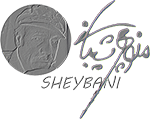

PROFESSIONAL LIFE AS A POET
Publication of his first poetry book in 1945, with thirty-six poems, titled Jaraggeh (The Sparke), earned him
critical appreciation.
Prior to that, in 1936 his first poem Alborz, The Volcano, was published in the Labor’s Magazine of Gaemshahr.
Sheybani was the youngest modernist poet participant who got recognition for his poem entitled Iran, at the
First Iranian Writers Congress in
1946 (Ricks). In the same year his poem Gazab, the Wrath was published in the journal of Jam-e-jam nbr.2
Sheybani joined Khorus Janggi (The fighting cock), an artistic and literary circle founded in 1949 by the
painter Jalil Ziapur. its main objective was to
look for a new language in art and literature. Ḵhorus Janggi also published a journal by the same title, with
Sheybani as its first poetry editor.
In 1953 he started his collaboration with Al-E-Ahmad and Simin Daneshvar for the journal of Nagsh-O-Negar.
His second collection of poetry, Atashkada-ye Khamush (The Silent Fire Temple), was released in 1964.
His third collection of poetry, titled Sarabha-ye Kaviri (The Desert Mirages), was released in 1974.
An Anthology of Poems was published after his death In 1991.
He had several poems published in various magazines and journals over the years. He also left behind a wealth
of unpublished handwritten
notebooks of poems.
In his poems, Sheybani choice of words is based on their acoustics and meaning without bounds to rules of
rhymes or meter. He uses mainly Stanzas of different kinds and varying line lengths that are free-flowing
verses without formal construction.
He is also regarded as one of the country’s earliest modern dramatist poets. The compositions of his poems
with dramatic dialogue and monologue help the readers to appreciate the unconventional language and structure of his
poetry. This characteristic displays his lifetime engagement with dramatic arts (Nuri-Ala).
The work at the textile factory exposing him to the living conditions of people quite different from the
comfortable life he used to have had a significant impact on his poems.
His choice of subject and theme in his poetry, was motivated by the harsh working conditions in the
industries, the subpar living situations of the workers and farmers, and his exposure to revolutionary
ideas to improve these conditions.
In his poetry, he focused on subjects like humanism, aversion to war, solidarity for the oppressed,
suffering, and a portrait of the real face of Iranian women (Babachahi).
In a letter to Sheybani, Nima Youshij, regarded as the father of modern poetry in Iran, said he was
familiar with his poems. and added "I feel that you selected a style close to mine in Poetry to be able to
express what our people need...Our approach besides being comparable, allows us, without doubt, to talk
about the everyday concerns of our people, the way they expect us to do.
Sheybani is recognized as being the first poet who experimented with free verse white poetry, known as Nima
Yushij's very first followers his genre does not fit Nima Yushij's poetic structure.
In 1936 Sheybani’s first poem Alborz, The Volcano, was published in the Labor’s Magazine of GaemShahr. His first poetry book was published in 1945, with thirty-six poems, titled Jaraggeh (The Sparke) which earned him critical appreciation. Sheybani was the youngest poet participant who got recognition at the First Iranian Writers Congress for his free-verse poem “Iran”, in 1946 (Ricks). In the same year his poem “Gazab”, the Wrath was published in the journal of Jam-e-jam nbr2. Sheybani joined “Khorus Janggi”, The fighting cock, an artistic and literary circle founded in 1949 by the painter Jalil Ziapur. its main objective was to look for a new language in art and literature. Ḵhorus Janggi also published a journal by the same title, with Sheybani as its first poetry editor. In 1953 he started his collaboration with Al-E-Ahmad and Simin Daneshvar for the journal of Nagsh-O-Negar. His second book of poetry, “Ātaškada-ye Khamush” The Silent Fire Temple, was released in 1964. His third book of poetry, “Sarābhā-ye Kaviri” The Desert Mirages, was released in 1974. An Anthology of Poems was published after his passing in 1991. His poems were published in various magazines and journals over the years. He also left behind a wealth of unpublished handwritten notebooks of poems.